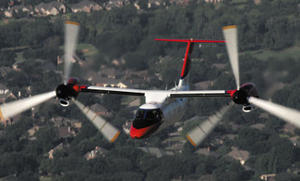Shape of things to comeFlying-boat tilt-rotor catamaran design wins NASA rescue vehicle competition
Engineering students from Virginia Tech won first prize in NASA’s competition aiming to promote the design of more effective rescue crafts; the winning design, dubbed the Rescue Amphibious Firefighting Tiltrotor (RAFT), is a combination airplane/helicopter/catamaran featuring two flying-boat style hulls joined by a central wing to form a catamaran for landings on water even in rough seas

The BA609, the world's first civilian tilt rotor aircraft // Source: astroaviator.com
American Engineering students have won a NASA competition with their design for a combination airplane/helicopter/catamaran rescue craft. Students from the united Kingdom worked on the runner-up design, a quadruple-rotor version of the V-22 Osprey craft.
“The designs were creative, innovative and looked at many issues in detail,” said Susan Gorton of NASA’s Subsonic Rotary Wing Project. “Reading the student papers highlighted how many bright young engineers are interested in the future of rotary wing vehicles. I certainly hope some of them decide to work with NASA as a career choice.”
Lewis Page writes that the NASA Aeronautics Amphibious Tilt Rotor for Civilian Operations Competition was set up by the space agency’s Aeronautics Mission Directorate through its Fundamental Aeronautics Program.
The winning design, dubbed the Rescue Amphibious Firefighting Tiltrotor (RAFT), was developed by ten engineering students at Virginia Tech. It features two flying-boat style hulls joined by a central wing to form a catamaran for landings on water even in quite rough seas (up to sea state 4).
Projecting wings on either side carry swiveling nacelles like those of today’s V-22, but more powerful and featuring larger propeller/rotor blades.
According to the designers’ calculations the RAFT would be able to cruise at 300 knots and offer range of 800 nautical miles on a fill of just over 4.5 tons of fuel. It could carry up to 50 passengers or approximately 5.5 tons of water for firefighting purposes, which it could easily scoop up by making a brief touchdown on a handy body of water. The powerful catamaran flying-boat/copter would weigh in at a hefty 28+ tons all up.
Runner-up was the Civilian Aid, Emergency Search and Rescue (CAESAR) concept developed by students at Georgia Tech in Atlanta and the University of Liverpool in the United Kingdom.. Page notes that CAESAR uses a more conventional mono-hull and thus is judged safe to make water landings only in sea state 3 or less. It features four wings, each with a swiveling tilt-rotor nacelle, and so does not need such long blades as the RAFT.
In all other respects the CAESAR appears to offer equal potential to the RAFT, but the better rough-sea stat seems to have carried the day. The winners walked away with a $5,000 cash prize, and selected students also won paid summer internships at NASA.
The competition for 2010/11 is on a different theme: green aviation. See details on the Environmentally Responsible (Green) Aviation College Student Challenge at NASA Web site.
